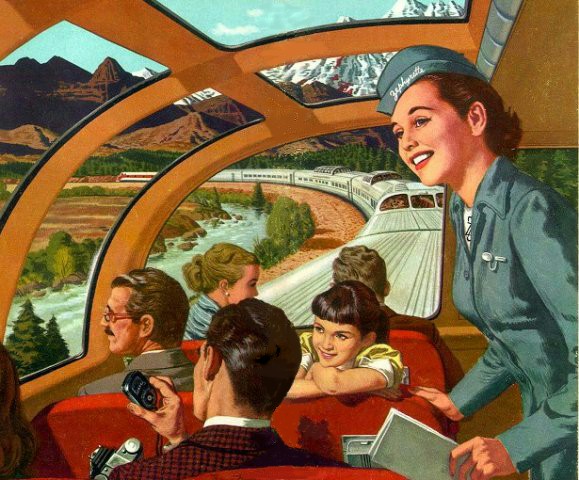California Zephyr
Here's a song for you to listen to while you read this post, The Train Kept-a-Rollin' by Johnny Burnette:
Why drive when you can fly like the West wind aboard the California Zephyr? This Superliner passenger train runs daily along Amtrak’s 2nd longest, most stunningly scenic route from Emeryville (an Oakland suburb) to Chicago and back. Intermediate stops include Sacramento, Reno, Salt Lake City, and Denver. While the length of each train varies, the train we rode was comprised of eleven cars. First came the two engines, followed by one crew car and three coach cars where the majority of passengers (including us) had reserved reclining seats that doubled as beds. Smack dab in the middle was the lounge car, aka the observation deck. Strategically designed to maximize passengers’ simultaneous drinking and sightseeing experiences, it featured immovable chairs and beverage tables, which eliminated any possibility of passengers knocking them over due to the train’s jarring motion or their own sloppy drunkenness. Enclosed with glass walls and ceilings, there's never a bad seat in the lounge car. Only if you were totally passed out would you miss the spectacular vistas for which the California Zephyr is celebrated by railway enthusiasts. Next came the dining car, where each white linen-covered table was graced by porcelain place settings, metal cutlery, and a red rose in a silver vase. For breakfast, lunch, and dinner, passengers were served freshly prepared entrees and beverages by bow-tie-wearing servers. Bringing up the rear of the train were three sleeper cars. You may think of the sleeper car passengers as VIPs who can afford to travel in luxury and style or hedonists who can afford to pay for the temporary license to engage in discreet sexual activities while traveling cross-country by rail. Both perspectives contain a kernel of truth.
The original California Zephyr, known as "the most talked about train in America" was jointly operated by the Chicago, Burlington & Quincy (CB&Q), Denver & Rio Grande Western (D&RGW), and Western Pacific railroads. Nicknamed “CZ” or “Silver Lady,” it first started running in March, 1949, and ceased operation in 1970.
Amtrak appropriated the name California Zephyr in 1983 and applied it to its newly-designated daily route that was a hybrid of the original train and its former rival, the City of San Francisco. At Denver Union Station, on July 17, 1983, Beulah Bauman officially christened the new train with a bottle of California sparkling wine, thereby securing its rightful place in heaven. Ms. Bauman was given this honor due to her former career as a Zephyrette. Another former Zephyrette, Julie Ann Lyman, called her fellow train hostesses “the railroad's answer to the airline stewardess." The Zephyrettes performed a wide variety of duties from first aid responder to babysitter to tour guide. But partying was strictly forbidden. The Zephyrettes were required to conduct themselves with "dignity and poise" at all times, to “refrain from smoking or imbibing alcoholic beverages while in uniform,” and to avoid socializing with boozing passengers. Worse yet, Zephyrettes were not permitted to receive tips (although they could accept cards and gifts). Ms. Lyman once remarked that her greatest cravings after completing her shift were for a glass of wine and a cigarette.
Tragic, we know, but Amtrak’s modern revival of the California Zephyr does not feature Zephyrettes gone wild. The highlight of our trip was the historical narrative periodically provided by personable conductors in the lounge car/observation deck. When the train winds its way up through the Sierra Nevadas, make sure you wear your hats and scarves because the lounge car's glass walls won’t insulate you from outdoor temperatures colder than a witch’s teat.[1] At first glance, we saw a deceptively serene picture-postcard image of frosted forests, but after 20 minutes of observation, the destructive effects of the invisible merciless wind had become terrifyingly obvious: Towering trunks with their crowning branches shorn off. Snowbanks so deep that baby trees were buried alive inside. Branches bending under the weight of their load, dumping icy piles of snow that pelted the roof of the lounge car and slid down the glass walls into oblivion. No wonder the Donner Party resorted to cannibalism in order to survive out there.
Particularly fascinating was the ghost town of Boca, nestled in a Sierra canyon and cursed with the lowest recorded temperatures in California (the record low was 45 degrees below zero). The resourceful citizens of Boca turned their curse into a blessing back in the 1800s by developing a successful ice-producing enterprise, which shipped thousands of quarts of ice into Eastern markets from the years immediately preceding the turn of the century until 1929, when technological advancements in the commercial ice production industry eliminated the need for the natural stuff. Demonstrating a resilience, stubbornness, or some combination of both that undoubtedly stemmed from their pioneer spirit, the Boca folks switched gears and ramped up their burgeoning beer industry. Boca beer was so popular that it was sampled at the 1888 world’s fair in Paris. Oo-la-la! Way ahead of its time, with no craft beer industry to speak of for another 100 years, the brewery could not sustain the town and Boca officially “died” when the post office was shut down in 1945. We shed real tears as we imagined the postmaster downing a bottle of Boca beer before turning the key in the lock for the last time.[2]
Leaving California, our train entered Nevada through the Truckee River Canyon and Washoe Valley, where the elevation was 4,920 feet. The historical narrative concluded when we arrived in Reno, where passengers departed in droves to go to the casinos, leaving Close Encounters of the 3rd Kind mountains of rubbish behind. “I guess the trash can was too far away for these people?” quipped a steward sarcastically as he tossed bottles into a bin within arm’s reach of the tables where the thirsty hordes had been sitting just moments ago. Karmic justice prevailed in the end because the gamblers missed the most incredible part of the trip where the Zephyr zooms through the depths of the Utah canyons flanked by steep mesas, and then follows the flow of the mighty Colorado through the Rockies. (we'll tell you all about if you keep on reading).
The conductor resumed his narrative 5 minutes after the mass exodus, glowing with local pride as we passed through the towns of Helper and Wellington where a notorious cohort of outlaws used to wreak havoc. Among them were Butch Cassidy and The Sundance Kid. Like the conductor, Butch was born and raised in Utah. His real name was Robert Larry Parker but people called him “Butch” because he had been trained as a butcher and “Butch” was a common nickname for butchers at that time. Point of interest: Butch Cassidy never killed anyone, a fact of which he was proud. He was a “Robin Hood” figure who stole from banks and railroads to assist the locals in their attempts to retain their lands, which were being stolen by none other than those very same banks and railroads. Ah, the Circle of Life! We didn’t learn much about The Sundance Kid – only that his first name was Henry and that he was originally from the East Coast. Why he went gallivanting through Utah with Butch giving rich dudes a pain in the keister remains a mystery.
Keep your eyes peeled for a classic photo op at the Utah/Colorado border where some lunatic painted the words “Utah” and “Colorado” right next to each other on the mesa. Equally photo-worthy are the “Book Cliffs,” a long stretch of coral colored mesas that resemble a celestial bookshelf. If you look carefully, you’ll see crumbly looking crags between the mesas. The Anasazi Indians, aka “The Cliff Dwellers,” used to climb these crags to reach their farms on top of the mesas. An ancient agrarian people, the Anasazi cleverly engineered a method of irrigating their bountiful crops of corn, beans, and squash with water from the Colorado River. Suddenly, the Anasazi vanished and their disappearance remains one of the greatest unsolved mysteries of all time. Anasazi petroglyphs (rock carvings) and petrographs (cave paintings) depict bizarre looking creatures, which has led people to postulate that the Anasazi were in contact with extraterrestrials who absconded with them to their planet. Go ahead and laugh, but it’s just as plausible as any of the explanations proposed by scientists.[3]
Then came the Rockies. Words cannot describe how awesome these mountains are but their psychoactive effect on the individual is easy to explain. First, the Rockies will make you deliriously giddy like a little kid. You will jump up out of your seat gleefully trying (and failing) to capture their sublime magnificence with your camera. Then, after mile after mile of evergreen trees mixed with red clay mixed with white snow drift by, you will lose track of time completely and humbly acknowledge your insignificance.
Hundreds of miles of spectacular natural scenery flew past our faces before we saw a house. It was constructed of wood with a grand front porch and a spacious garage. A multitude of vehicles were parked in the driveway as if a meeting or social gathering were taking place inside. (Was it possible that the inhabitants of the house owned all those vehicles?) Then, the house disappeared from view like a mirage, and we didn’t see another house for at least half an hour. We didn’t see any stores or gas stations either. We wondered where the closest hospital was and surmised that if you were to suffer from a heart attack out there, you would just die and the animals would clean your bones, which is what happened for centuries before modern medicine. But this posed an interesting question: Despite the avalanche of complaints we hear about our health care system (it costs too much, it doesn’t allow doctors enough time with patients, it’s driven by insurance companies’ agendas, etc.) do you know anyone who has rejected it outright as superfluous? We don’t. The inhabitants of the house with no neighbors and a multitude of vehicles in the driveway essentially said: “Nah, we don’t need health care. We don’t need anything except ourselves.” These human beings must possess a brand of ferocious independence that we, entangled in our web of urbanity, have never before encountered but would relish the opportunity if the occasion should arise.
[1] Just how cold is that exactly? “Usually, when someone says it’s ‘colder than a witch’s teat,’ you can assume the temperature is less than ten degrees Farenheit,” says University of Maine climatologist Jeff Churchill. “But there are variations, depending on whether the person was simply going out to get the mail, or was maybe trying to chop frozen firewood.” See https://sardinereport.wordpress.com/2012/02/11/exact-temperature-of-witchs-teat-eludes-scientists/.
[2] We’re not as depressed that the town of Boca died so much as that it died before we had the chance to try Boca beer. It’s not only totally impractical but it’s the epitome of arrogance to think that humans have any business living in temperatures fit for polar bears. But that’s precisely the type of “I don’t care if I fall into this vat, I’ll die drunk and happy” dogged persistence required to create the perfect beer. Thus, it is our sincere wish that the former inhabitants of Boca did not give up hope and that they eventually found a suitable clime for brewing. If you have any information on the subject, please send an email including your sources to GlitterchickenEditor@gmail.com and your name will be enshrined upon our Wall of Fame for all eternity.
[3] For more information about the alleged connection between The Anasazi and extraterrestrials, see http://www.theuforeportcenter.com/anasazi-disappearance/.

